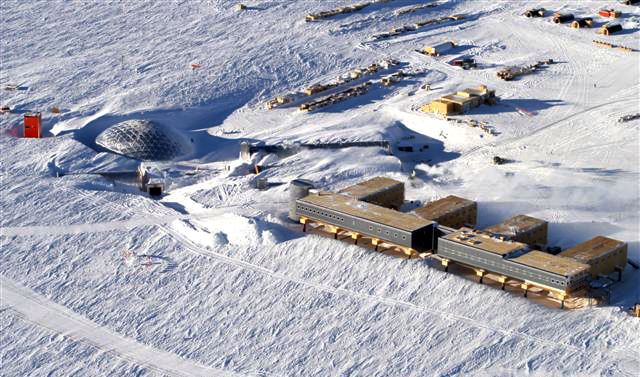
Photo Credit: Emrys Hall/NSF |
An aerial view of the South Pole Station, site of the fifth annual South Pole International Film Festival. This year's amateur filmmakers spoofed life at the bottom of the world, but also honored the memory of Sir Edmund Hillary. |
Spoofing on SPIFF
South Pole film festival captures skewed perspectives from the bottom of the world
By Margaret Adams, South Pole correspondent
Posted February 15, 2008
“Are you ready to get your SPIFF on?”
These words, directed at the packed-to-capacity galley at the South Pole Station, opened the 5th annual South Pole International Film Festival (SPIFF), screened here on Jan. 26, 2008.
The SPIFF is a well-loved tradition. Anyone can participate; cameras and film gear are made available, as well as movie programming software and tutorials. SPIFF lets Polies exercise their creativity in their free time — and document this unique living environment at the same time.
People began talking about their thoughts for this year’s films before getting off of the ski-equipped LC-130 that shuttles personnel from McMurdo Station to the South Pole. SPIFF has been a regular dinner-time topic for months, stirring everyone’s imagination. A fall showing of the “Best of” previous SPIFF entries helped garner enthusiasm and spur people on to make their ideas turn into realities.
While the turnout this year was admittedly small — amateur filmmakers only entered nine movies, a total of 46 minutes — the showing, by all accounts, far exceeded expectations.
“The humorous, representative, and above all personal films here at 90 degrees South,” were the introductory words of host Mike Rousseau, an IT network engineer. Anything goes at SPIFF: nothing is censored before the showing. The films are a fertile ground for station editorials and self-mockery alike.
The first and arguably one of the crowd favorites was “Beacon,” directed by Tom Piwowarski. Mocking and celebrating one of the irritations of South Pole, Beacon depicted a Polie barred from crossing the landing strip by our crossing beacon — with no plane in sight.
The despondent Polie looks high and low for a plane in a series of beautifully filmed angle shots (including the reflection of the flashing beacon in his polarized sunglasses) but to no avail. During his dramatized wait, he pours himself coffee, smokes a cigarette, peels an apple, and even does pushups. The scene then changes to reveal the reason behind his plight: a Christmas party is being thrown in the Communications room, and someone has put a plate down directly on top of the crossing beacon switch.
“End of Quad” by Tom Culverhouse and Jamie Hinderks commemorated the shutting down of the Quad telescope, a cosmic microwave background experiment. The memorial service was performed to the funereal sounds of “Amazing Grace,” right up to a sheet being sorrowfully draped over the telescope’s lens. An unseen narrator asked one mourner, “What did the quad mean to you?”
“Three years of fun,” he answered, and the music changed suddenly to Journey’s “Don’t Stop Believing,” bringing the audience from a nostalgic wistfulness into celebration. The end credits elicited a small sigh from all. Such is the mercurial life of science funding.
Shelly Denike’s entry consisted of direct sound transcripts, photographs and video of a call made by Sir Edmund Hillary to the South Pole from McMurdo Station in 2004. Hillary, who died on Jan. 11, had been a major figure in Antarctic history. He made the high frequency (HF) call to South Pole on one of his final trips to the continent.
While the man who first scaled Mount Everest was elderly and the HF line crackled, the spirit of this New Zealand legend still came through. It was a timely edition to this year’s festival.
Three films were done by the galley crew, showing the “unseen side of the galley” and ”what really happens on night shift.” This included everything from station sabotage, to spa treatments and dance parties. All three will probably increase applications to the galley next year.
Mark Eisinger said the film festival serves as a record of each season and its unique group of people. “People look forward to the Race Around the World and to SPIFF more than any other event,” he said. “Everyone has New Year’s and Christmas parties, but these events are truly unique and anticipated highlights in the summer season.”
Many Polies are involved as actors and support crew. “Its fun for me to have a lot of people involved in this,” said Eisinger, who works as a crane operator.
Filming challenges are certainly many — among them, of course, being the effects of the intense cold. A camera battery can last about five minutes without freezing up.
How did SPIFF start here at South Pole — and how has it become such a quality tradition? Some say that it’s the environment that inspires. “I mean, look at where you are,” Eisinger said. “You’re at the bottom of the world — just look at what you can come up with.”
Other opinions also credit the environment, but with perhaps more cynicism: “It’s a good distraction,” said Liz Mcdaniel, a dining assistant who had a hand in several films, “from the everyday reality of our jobs and from this crazy place.”
Distracting from or inspired by our extreme location, the South Pole International Film Festival is certainly a surprising — and consistent — success.





